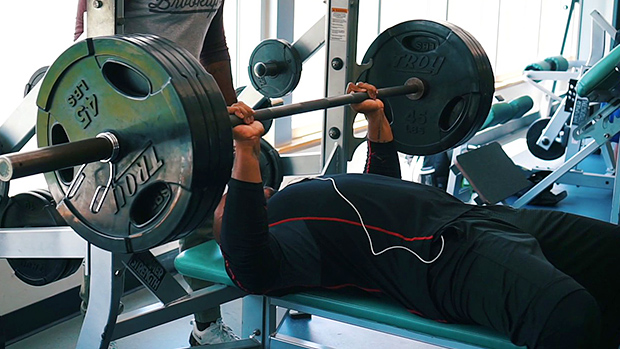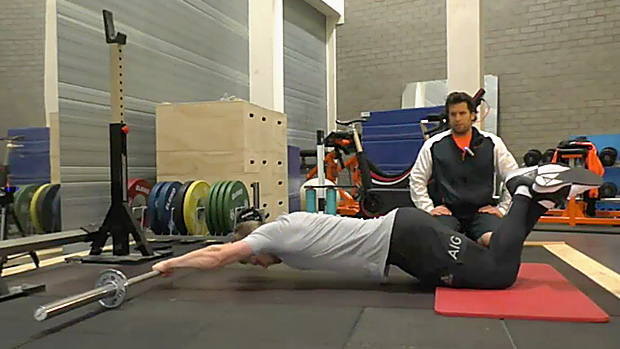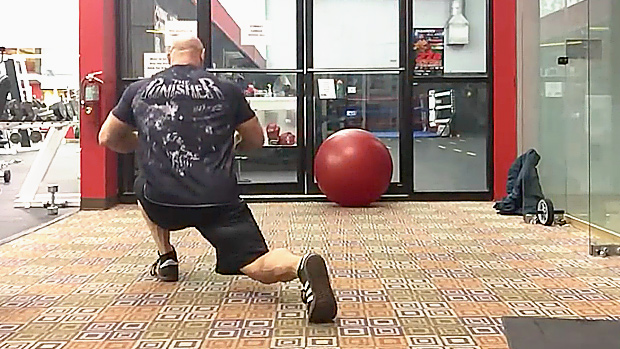There's a statistic floating around stating that the average lifting career lasts for six months. I know what you're thinking – I have some vegetables in my refrigerator older than that.
This article isn't intended for the average types. It's intended for you, the lifter that's hung around for a while, hit some big PRs, and wants to chase even bigger numbers.
However, I'll caution you. At some points while reading you may smack yourself in the forehead and say, "How the hell did I forget about that?" Of course, I'll interweave creative solutions, but like the resolutions to most lifting issues, it isn't rocket surgery.
Full-Body Tension
The bench press is a great measure of upper-body strength, but as many lifters often ignore, it's also outrageously technical – that is, if you want to move big weight. If you're happy with moving 200 pounds like a grandma shoveling snow, then certainly, disregard the following paragraph.
A technically sound bench press rests solidly on a foundation built by tension. Even though your back is resting soundly on a pad, looseness promotes energy leaks that demote power output. Since the body is a large piece of equipment, and the bench requires a great deal of technical tightness, let's examine full-body tension in list form.
- Is your grip tight, and are your wrists straight?
- Have you "broken the bar?"
- Is your chest pushed up to the bar?
- Is there so much air in your abdomen that you feel it pressing into your spine as well as your gooch? (The technical term for the space between the genitalia and anus.)
- Are your feet pressed into the floor with so much force that your glutes feel like they could cramp?
If you answered no to any of these questions then you aren't tight enough. If you want the rest of your bench press problems to disappear, you must start here.
Finishing Strength
I've been affectionately called the orangutan – I'm orange and my knuckles swing dangerously low to the ground. Couple my long arms with less than broad shoulders and you've got the makings for a lockout that's perilously lacking. It's a big weakness that I've spent a fair portion of my life improving.
If you're lanky-armed like me, chances are your lockout is poop. But if you're one of those broad chested few that blasts weight off their chest but have a hard time carrying it through to complete elbow extension, your lockout sucks, too.
Shoulder Positioning
This problem is listed third, but it's the number two problem behind full-body tension that I encounter when coaching the bench press. Sure, lots of properly placed tension will keep the shoulders locked in position, but most trainees need a drastic reminder of just where their shoulders are supposed to be.
If you feel your upper-back flatten, your shoulder blades separate, and your elbows flap loosely away from your body, you're lacking shoulder positioning.
Starting Power
I'm not sure why, but I've seen a lot of lifters turn the bench press into a grind. Don't get me wrong, grinding is all right – just save it for competition efforts or when a fine young woman wants to back that thang up.
Unless a lifter has played a sport like football, MMA, or been a track and field thrower, it's often that they lack dynamic power in their upper body. Most of the time these are the only guys I see that press with power.
The diagnosis is simple. If you often find yourself with a barbell stapled to your chest and fail early on in bench efforts, then you need more starting power. For confirmation, put 60% of your one-rep max on a bar and press it concentrically as fast as you can. If it doesn't move from point A to point B in one second or less, you're too slow, Jack.
Here are some exercises that should help the aforementioned problems.
If Your Problem Is Full-Body Tension
I prescribe chaos push-ups and one-arm bench press.
I learned chaos push-ups from my friend Jim Smith – they're also included in the DVD he produced with Joe DeFranco, EXTREME. Check out an example below.
Nothing forces tension quite like the fear of falling on your face. The vibration of the bands also makes this a great shoulder pre-hab exercise – it gets the smaller stabilizing muscles firing. Be sure to perform these suckers slowly – at least a three-second eccentric with a matching concentric with a pause in the bottom position. I'll cue you to use full-body tension, but you'll find out when you try them. Cues aren't necessary.
When I first started coaching, I read a lot about Ethan Reeve, the head strength coach at Wake Forest University. He's not flashy, but he follows sound principles and makes his athletes work, something most need more of.
Coach Reeve loves the one-arm bench press – as a standard, he wants his athletes to press a 100-pound dumbbell for 5 reps. It makes sense for football players that have to press to an edge and it offers a lot in the way of core anti-rotation strength.
For our purpose though, it goes a long way in teaching full-body bench press tension – it's more specific than chaos push-ups.
Try to one-arm bench without braced lats, solid air, and your feet pressed into the floor – I dare you. You'll roll like a canoe and sink like the Titanic.
If Your Problem Is Finishing Strength
Try the overhead pin press and 3-board bench press.
I've heard many stories that start this way: "Dude, I had 315 pressed; I just couldn't quite lock it out." Sadly, good sir, you did not have 315 pressed – what you had was a three-quarters rep followed abruptly by a failure.
Quick aside: We're clear that fail is a verb, right? Failure is the noun. So it's impossible to be, or have something be, an epic fail. That's stupid. I italicized epic to accentuate the stupidity.
Partial reps, however, are useful in the fight against failure.
It's not completely bench specific, but the overhead pin press amasses triceps and delts pressing strength. Pressing from a dead stop makes that pattern's circuit turn on quickly, building power to accompany the strength, provided that you make a concerted effort to move the bar with verve. Specific bench lockout training, however, is also advantageous.
I've been lucky enough during my career to train with some of the best benchers in the world. Mike Wolfley, a guy that's benched in the upper 700s at a bodyweight of 198, fortunately lives 45 minutes from me. The guys from my gym and I have taken quite a few trips to train with him in Beaver Springs (good luck finding it on a map)!
Mike, of course, is an equipped lifter. But he speaks often about three-board work, a bench variation that works well for equipped and raw lifters.
The three-board is magic. It carries the bar through the mid-range dead zone where many bench efforts are hustled off to the iron graveyard, but it also puts the elbows at an angle to build lock out strength. When I'm struggling, it's my go-to bench assistance exercise.
If Your Problem Is Shoulder Positioning
Practice the Iso-hold Bench Press.
At some point during life, everyone goes through the five stages of grief. You lose a loved one, perhaps there's a big break up, or, cue the music, you forget your Surge® Workout Fuel drink on top of the car and you watch helplessly through the rearview mirror as it falls.
If you've yet to experience any of these situations and, in turn, have missed out on grieving, the iso-hold bench will speed you through the process. Before you start, you'll deny the exercise's necessity and about 30 seconds in a wave of anger will hit.
Soon after, you'll begin to bargain. The thought, "I don't need to fight the whole way to my chest. I'll just stop after 2 minutes," will race across your mind. Depression follows soon after as the pain mounts. Then, as the bar is a few inches from your chest, you accept your fate and fight like hell.
The video was just an example – that's not the true iso-hold bench. Had I been doing it beyond example's sake, I would've fought the bar the whole way to my chest, staving it off for as long as possible. I also wouldn't have pressed the bar off of my chest – it wouldn't have been possible. Someone would've dragged it off me.
Click play and watch the video again. Pay close attention to my elbows and rib cage. Did you notice that my elbows stay under the bar and in line with my wrists? How about my chest and rib cage? Did you notice that they continually rose as the bar came down?
These are the true lessons, at least for the sake of shoulder positioning, from the iso-hold bench. Keep breaking the bar and driving your chest up as you fight the bar to your chest. If that doesn't teach you shoulder positioning, along with healthy grieving, then you might be out of luck.
If Your Problem Is Starting Power
Try dead start upper-body box jumps.
This article is, of course, about benching. There are about a million pin press, pause press, and concentric-only bench variations that we could talk about to build starting power. Sometimes, however, we just need to move our bodyweight as quickly as possible.
As the textbooks tell us, power is force vector and plane specific. Dead start upper-body box jumps meet both of those ends for bench press starting power. The 2-3 second pause in the bottom position alleviates any carryover of the stretch reflex.
If you're short one bench, aerobic steps also work well. No steps? Try weight plates. Not enough of those? Try dead start plyo push-ups. However, I like the box jump version more because it offers reinforcement of how much might is necessary for success.
Once again we've filled a tool box of tonics that require prescription. But as I've mentioned before, variation without an end in mind is purposeless, unless you're just playing.
Chaos Push-Up
To keep myself organized, I label exercises based on where I place them in workouts or programs. I file chaos push-ups under the bookend category, meaning they're great as a prep exercise and as an assistance movement.
For prep purposes, 1-2 sets of these bad boys with a 5 count in each direction works well. You'll elicit a nervous system response and avoid fatigue. If you're programming them for assistance, increase the volume.
I'll caution you, however, to be conservative – if you're new to chaos push-ups you'll tire quickly and tension, along with form, is important. Don't be a hero and put yourself in a bad position.
One-Arm Bench Press
The one-arm bench press shares categories with chaos push-ups in this article and in my exercise file Rolodex. They too are a bookend exercise.
When using them, or any exercise in this program, for that matter, avoid high reps – for safety and productivity, form is too important. Keep the reps per set at 8 or under to avoid getting sloppy.
Overhead Pin Press
The overhead pin press is a maverick. Because of the limited eccentric loading, it can be trained every day. That is, of course, depending on how heavily it's loaded.
Overhead pin presses work well as a CNS ramp-up exercise, a main movement, and as an assistance movement. I like loading them with triples, singles, and cluster sets. Again, we want to avoid turning the exercise into a mess.
3-Board Bench Press
Those of you that are Westside for life know that the 3-board press is a great max effort exercise. It's also great as a submaximal main exercise and as an assistance piece. This is a bench variation that can be taken to extremes.
I already said it works well as a max effort exercise, but if you're into rep work, this is the variation I'll prod you to choose. The shortened range of motion takes stress off the shoulders, but you can still work form with time under tension. Along with the gems from the previous sentence, high-rep 3-board presses load up the triceps like an Irishman on St. Patty's Day.
Iso-Hold Bench Press
After watching the video, you're probably hoping to skip this variation. No need for prescription, Todd – I'm not doing that miserable shit. Well, friend, you don't have to use it, but you're sure as hell going to learn how to.
Place the iso-hold bench at the beginning of your bench press days. Though they look exhausting, the fatigue is mostly neural. Give your nervous system ample time to recover, and you'll be able to go about business as usual. Since they promote a strong neural adaptation – along with our goal of shoulder positioning – I like them most at the beginning of a dynamic effort upper-body day.
Dead Start Upper-Body Box Jumps
Like the overhead pin press, dead start upper-body box jumps have very little eccentric loading. That makes them a great every day exercise. If you need power and can train it every day, then train it every day. Building total volume is fine, but keep the intra-set reps low – 5 or lower. Push for higher boxes with solid form.
When the Apocalypse hits there'll be three things left – cockroaches, Twinkies, and bench press articles. If this piece helps solve your bench press quandaries, I'll be glad that I've contributed to the library of the most discussed lift on earth.





